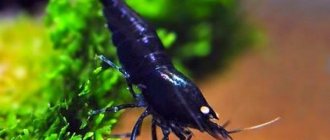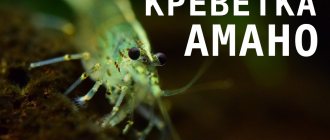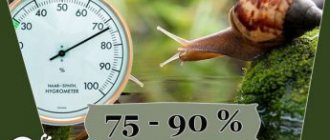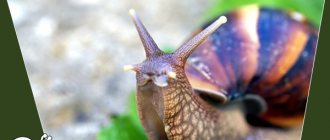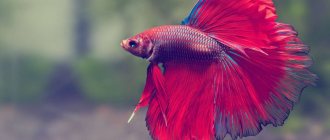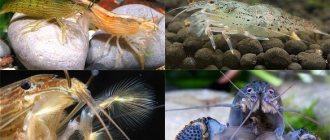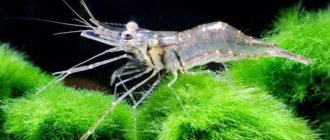This aquatic inhabitant is called banana, forest, tree, Singapore shrimp, athyopsis, but its main name is filter-feeding shrimp. The creature received it for its ability to purify water from various bio-debris - food debris, microorganisms, vegetation. These shrimp are considered valuable inhabitants of the reservoir, as they improve the environment. To some, filter feeders may seem unattractive, boring aquarium inhabitants, but in fact, watching them is quite entertaining.
Habitat in nature
The natural range of the crustacean covers the Moluccas Islands, part of the Indonesian archipelago. The species is distributed in many freshwater basins of southeast Asia. When living in nature, crustaceans prefer rivers with moderate currents, rocks at the bottom and a small amount of vegetation.
Filter feeders live in groups and feed on plankton and small organic particles. For successful reproduction, the presence of a current is important. Adults live in fresh watercourses, but young animals require salt water to develop. Therefore, the fry go with the current to coastal sea waters, and as adults return to their native channel.
Description
The filter feeder shrimp is the largest aquarium species of crustacean. The body length of an adult is up to 10 cm. The shape of the body is elongated, slightly curved down, which is why the crustacean is called banana.
The main feature in the description of appearance is the modified front two pairs of limbs. They are fan-shaped and consist of many closely spaced bristles. The shrimp spreads its limbs so that water passes through fans placed perpendicular to the flow. Food particles get stuck in the bristles, and the crustacean sends them into the mouth. Each bristle has receptors that allow the crustacean to understand whether what it catches is edible.
The large size of the shrimp is due to the need to resist the current when catching food. The large weight prevents the crustacean from falling under the pressure of the water current. Due to their modified limbs, filter feeders are very clumsy and slow, because they have to move on only two pairs of unmodified legs.
The name of the species is not related to the ability of shrimp to filter water and perform a sanitary function. The aquarium filter-feeding shrimp got its name for its unique feeding method. The crustacean is not adapted to grabbing food or searching for it at the bottom, so if it gets into a body of water without a current, it is doomed to die, even if there is a lot of potential food around.
Filter feeders do not have a specific color. Body color depends on the habitat, conditions of detention, even emotional state. About 2 times a month, an adult shrimp molts, during this period it loses its appetite and hides in a shelter, since without its chitinous cover it becomes completely defenseless. The shed shell is readily eaten by the shrimp and its relatives.
Molting of filter feeders
Shrimp often change color. After molting, they always turn red, then quickly lighten and, depending on their mood, acquire a color from red-brown to pale yellow. In adult filter feeders, molting occurs irregularly - about once a month or less, and therefore algae even begin to grow on the shell.
Atiopsis
On the eve of molting, the shrimp stops feeding, it can simply sit in the current, closing its “fans”, or find some secluded place - almost all crustaceans do this, because after molting they are practically defenseless. When the molt is complete, the females (if males are nearby) fertilize the eggs and lay them on the pleopods.
Kinds
There are two types of shrimp, differing mainly in color:
- The banana filter shrimp reaches a length of 7-10 cm. The color combines warm shades: sand, light brown, dark brown, terracotta, bright red. The peculiarity of the species is a longitudinal white or yellowish stripe on the back.
- The Gabon filter shrimp reaches 15 cm. Its range covers West African rivers flowing in mountainous areas. The color is extremely beautiful, ranging from pale blue-gray or pink-blue to rich cobalt.
Care and maintenance
The main thing to do in an aquarium is to ensure a continuous flow of water. It is necessary to install external and internal filters, thanks to which an imitation of a river flow is created. It is recommended to equip the tank with a pump that continuously pumps water.
Due to the large size of the filter feeder shrimp, they must be kept in a large aquarium with a capacity of at least 60 liters for a small group.
Water parameters
Filters are not capricious in terms of aquarium conditions, but they need cleanliness, sufficient air and maintaining the stability of environmental parameters.
Recommended water parameters for crustaceans:
- Temperature – 23-28°C;
- Acidity – 5-7.5 pH;
- Hardness – 6-15 dH.
Shrimp do not tolerate an increase in the concentration of nitrogen compounds, the percentage of which in water should tend to zero.
Lighting
Crustaceans are active at night, so lighting is of secondary importance for them. Moderate light is quite enough.
Vegetation
Filters do not harm plants, the aquarium can be planted with any species to your liking. Shrimp especially like broad-leaved vegetation: Anubias, Cryptocoryne, Echinodorus. It is better to plant them in a row in the background to make it easier to observe how the crustaceans catch food.
Priming
Any soil that does not contain particles with sharp edges is suitable: gravel with a fraction of 2-5 mm, sand from 1 mm.
Decor
The aquarium should contain large decorative items: free-standing stones, driftwood. The shrimp climbs on them to catch food in the water column. Therefore, decorative elements should be installed along the flow.
If you ignore the decor when setting up an aquarium, crustaceans will climb onto the filter and climb into its pipe.
Habits of Athyopsis
These creatures swim quite well forward and backward. Most often they move head forward, but if there is danger they quickly back away.
These guys can often be seen on aquarium pumps and filters.
They are not bottom-dwelling creatures. Atiopsis move throughout the entire space of the aquarium: the bottom, surface of the water, decorative snags and aquarium equipment. The main condition is the presence of a strong current. After the water source weakens, they go in search of a new “turbulent” place. It can be installed independently near the filter exhaust. Make ridges on the glass using sticks and suction cups.
Young individuals prefer to hunt secretly. They hide under snags and leaves. The shrimp remain in this position for several weeks. With age, they become bolder and increasingly swim to the surface.
Sometimes the banana filter shrimp can perform various tricks to help it jump out of the aquarium. It is recommended to cover the vessel with a glass lid.
Behavior and Compatibility
You should not expect interesting behavior from the filter. The crustacean spends most of its time in a motionless state, with its fan-shaped limbs spread out. Occasionally changes position, moves to another place. If the shrimp begins to move actively, it means there is not enough flow power in the aquarium.
If the reservoir is small, filter feeders may become territorial. But the crustaceans are not pugnacious, they simply push each other, trying to take a convenient place to catch food.
The calm and phlegmatic filter feeder shrimp is highly compatible with all non-aggressive species. It gets along well with small crustaceans: neocardines, Amano. You should not house filter feeders with large crustaceans, macrobrachiums, or crystal shrimps. Among the fish, cichlids, large barbs, and all predatory and aggressive species will be bad neighbors.
High compatibility of the filter with:
- Sword bearers;
- Neons;
- Corridors;
- Guppy;
- Rasborami;
- Tetras;
- Pecilia.
Why are shrimp called filter feeders?
If you think that these crustaceans can serve as an aquarium filter, then we hasten to upset you: this is not true. The term “filter” refers to features of the anatomical structure; it defines the method of obtaining food by filtering water.
Filters catch food
This transformation of the limbs into small “fans” allowed the shrimp not to bother searching for prey: they just need to wait for the current to bring food itself. But this feature is also fraught with a certain danger - if a shrimp ends up in a body of water in which there is a lot of suitable food, but there is no active current, it is guaranteed to die of starvation. Because it will not be able to pick up food from the bottom or extract it from the water.
Feeding
Aquarium water has a low plankton content. We have to feed the crustaceans so that they don’t starve. The feeding process involves spraying food into the water in the direction of flow from the filter. The following can be used as food:
- Powdered dry fish food;
- Small bloodworms, nauplii;
- Living dust;
- Phytoplankton, crushed spirulina.
The filters are revived when the soil is treated with a siphon and the fish are fed. At this time, a large amount of nutrient suspension rises into the water.
Requirements for an aquarium
Filter-feeding shrimp do not have excessive maintenance requirements. Their ideal living conditions correspond to the following parameters:
Like all shrimp, Athyopsis have a positive attitude towards mosses and other small greenery.
- Neutral (or weak) alkaline reaction (Ph level above 7). The water hardness level should exceed 6-8 GH, but some individuals survive in both soft and slightly acidic water.
- The water should be free of increased amounts of nitrates (in particular, ammonia and nitrites). Their amount should be below 50 mg/l.
- Optimal water heating is 24-28°C. When the temperature drops to 22°C, the condition of the shrimp deteriorates significantly.
- It is necessary to ensure that the filtration and aeration processes run smoothly in the aquarium.
Breeding and reproduction
Due to the spawning characteristics of the filter feeder shrimp, breeding is an almost impossible task. Filter feeders reproduce at home upon reaching sexual maturity, when the body length reaches 3-5 cm. Shrimp eggs in the aquarium develop on the tail limbs of the female, newborn fry do not exceed 1 mm in length.
In filter feeder shrimp, reproduction occurs in a fresh environment, but the fry will not survive to adulthood unless they are exposed to salt water. And for adults, salt is harmful. The only option for breeding young animals is transfer to another tank with suitable conditions. But catching tiny fry is almost impossible, and choosing suitable food for them is problematic.
Therefore, it is easier for aquarists to buy adult specimens. Despite the large size of the filter feeder shrimp, the price is reasonable.
Nutrition
Shrimps use their fans to catch detritus, microorganisms and algae from the water, but such food is not enough in the aquarium.
Athyopsis should be fed with frozen cyclops, daphnia, catfish tablets, bloodworms and specialized food for shrimp.
Diseases and prevention
How long filter feeders live depends on nutrition and care, but usually 2 years. These crustaceans have strong immunity, and diseases are usually associated with starvation and poor-quality water.
Common causes of death are increased levels of nitrates and phosphates, low pH, and decreased oxygen. Due to poor quality water, shrimp die in 3-4 days, but dying from hunger can last a long time. The main sign of starvation is prolonged movement along the bottom in search of food.
Prevention - regular feeding of shrimp and maintaining clean water. For the full development of the chitinous shell, it is recommended to periodically pour chalk into the water.
